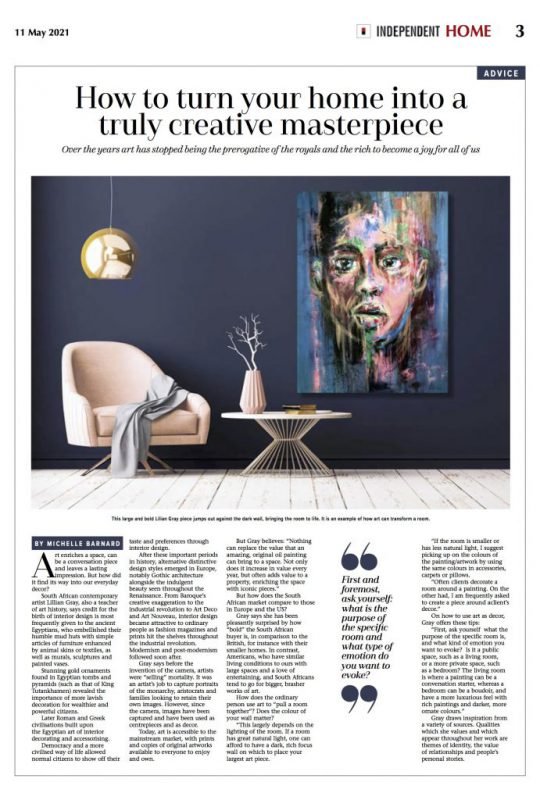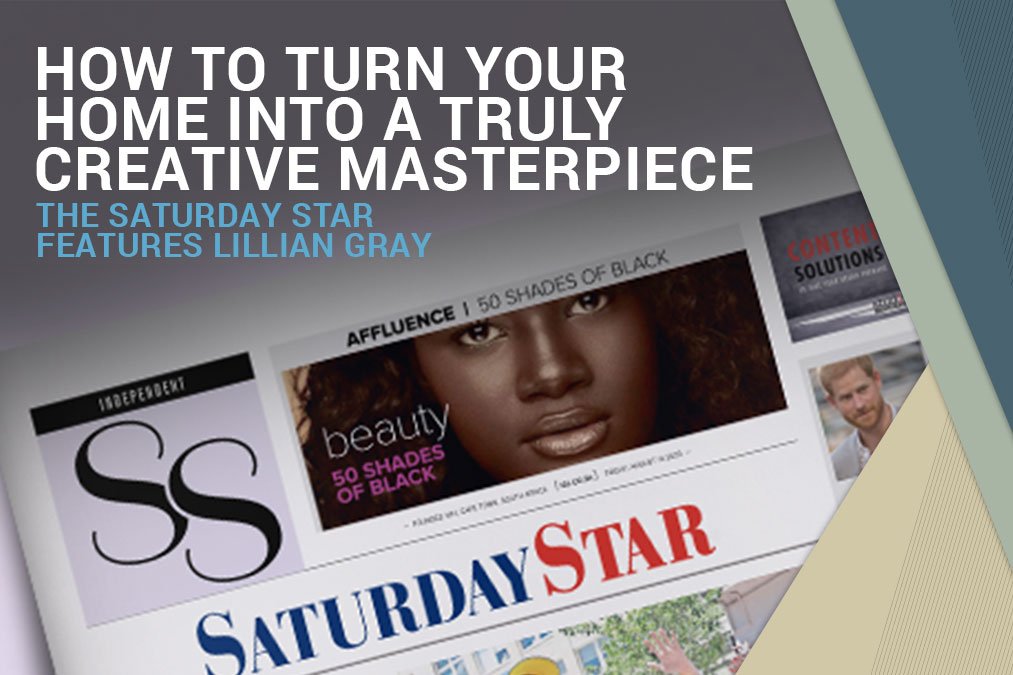No products in the basket.
In the News
Lillian Gray: How to turn your home into a truly creative masterpiece
Over the years art has stopped being the prerogative of the royals and the rich to become a joy for all of us

By MICHELLE BARNARD First Published in The Saturday Star on 11th of May 2019
Lillian Gray gives advice on “pulling a room together”
Art enriches a space, can be a conversation piece and leaves a lasting impression. But how did it find its way into our everyday decor?
South African contemporary artist Lillian Gray, also a teacher of art history, says credit for the birth of interior design is most frequently given to the ancient Egyptians, who embellished their humble mud huts with simple articles of furniture enhanced by animal skins or textiles, as well as murals, sculptures and painted vases.
Stunning gold ornaments found in Egyptian tombs and pyramids (such as that of King Tutankhamen) revealed the importance of more lavish decoration for wealthier and powerful citizens. Later Roman and Greek civilisations built upon the Egyptian art of interior decorating and accessorising.
Democracy and a more civilised way of life allowed normal citizens to show off their taste and preferences through interior design.
After these important periods in history, alternative distinctive design styles emerged in Europe, notably Gothic architecture alongside the indulgent beauty seen throughout the Renaissance. From Baroque’s creative exaggeration to the industrial revolution to Art Deco and Art Nouveau, interior design became attractive to ordinary people as fashion magazines and prints hit the shelves throughout the industrial revolution. Modernism and post-modernism followed soon after.
Lillian Gray says before the invention of the camera, artists were “selling” mortality. It was an artist’s job to capture portraits of the monarchy, aristocrats and families looking to retain their own images. However, since the camera, images have been captured and have been used as centrepieces and as decor.
Today, art is accessible to the mainstream market, with prints and copies of original artworks available to everyone to enjoy and own.
But Lillian Gray believes: “Nothing can replace the value that an amazing, original oil painting can bring to a space. Not only does it increase in value every year, but often adds value to a property, enriching the space with iconic pieces.”
But how does the South African market compare to those in Europe and the US?
Lillian Gray says she has been pleasantly surprised by how “bold” the South African buyer is, in comparison to the British, for instance with their smaller homes. In contrast, Americans, who have similar living conditions to ours with large spaces and a love of entertaining, and South Africans tend to go for bigger, brasher works of art.
How does the ordinary person use art to “pull a room together”? Does the colour of your wall matter?
“This largely depends on the lighting of the room. If a room has great natural light, one can afford to have a dark, rich focus wall on which to place your largest art piece.”
“If the room is smaller or has less natural light, I suggest picking up on the colours of the painting/artwork by using the same colours in accessories, carpets or pillows.
“Often clients decorate a room around a painting. On the other hand, I am frequently asked to create a piece around a client’s decor.”
On how to use art as décor? Lillian Gray offers these tips:
“First, ask yourself what the purpose of the specific room is, and what kind of emotion you want to evoke? Is it a public space, such as a living room, or a more private space, such as a bedroom? The living room is where a painting can be a conversation starter, whereas a bedroom can be a boudoir, and have a more luxurious feel with rich paintings and darker, more ornate colours.” Lillian Gray draws inspiration from a variety of sources. Qualities which she values and which appear throughout her work are themes of identity, the value of relationships and people’s personal stories.

Lillian Gray: Delightfully outspoken Artist with colourful opinions


Pingback: Riveting artist Lillian Gray featured in Art without barriers – Mango Juice - Lillian Gray - Art School